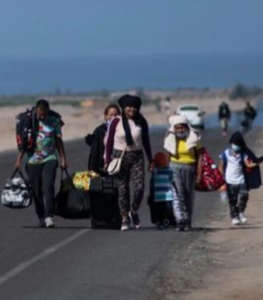New report charts trends driving humanitarian need
A confronting new report has identified some disturbing trends in the humanitarian sector that could see millions of people in need of food, medical care, shelter, or other humanitarian aid over the next year.
The report from the New Humanitarian journal comes amid ongoing conflicts and violence in Gaza, Ukraine, and the Democratic Republic of Congo; in Sudan, Haiti, Myanmar and elsewhere.
The report says increased efforts to deter migrants will drive deaths and abuses.
“The result in 2024 will almost certainly be a rise in the already staggering number of deaths in the Mediterranean and in the US-Mexico border; more and more people languishing in dismal camps along US and European frontiers.”
 Another result will be “expanded human rights violations and humanitarian suffering in countries of origin and transit; and the increasing instrumentalisation of migration as a tool to exert political pressure on the United States and European countries”.
Another result will be “expanded human rights violations and humanitarian suffering in countries of origin and transit; and the increasing instrumentalisation of migration as a tool to exert political pressure on the United States and European countries”.
The report says information warfare will put civilians at increasing risk.
“Misinformation and disinformation have always factored into conflicts and crises. But today’s tech, including easily accessible and rapidly evolving artificial intelligence multiplies the risks,” the report says.
“Generative AI may be the equivalent of the next, big mass-producible weapons, some analysts warn. Look at Gaza or Ukraine for snapshots of how information is weaponised. Examples of real-world harms are mounting elsewhere.
“In Sudan, both the army and the paramilitary Rapid Support Forces have waged an information war on social media – endangering civilians fleeing conflict with false information about safe areas,” it says.
Another risky trend is that water scarcity and drought will drive displacement.
“The Middle East and North Africa may be considered the worst-affected region, but water scarcity has become a global scourge, with droughts affecting everywhere from Peru to Kenya, from Syria to Afghanistan, from Honduras to Somalia to,” the report says.
“These events are only expected to proliferate as climate change worsens, with millions of people in fast-drying settings being pushed to cities for jobs that don’t exist. Children are particularly vulnerable to water scarcity, which is one of the main factors in preventable infant deaths. UNICEF says 739 million children – one in three globally – live in areas of high or very high water scarcity.
“Save the Children recently pointed out how water shortages linked to climate change increased the risks for children in Gaza.
“Conflict greatly worsens the situation, as in Yemen, where warring parties have both weaponised water and extorted citizens desperate for it,” the report says.
It also identified sieges during conflicts as potentially punishing civilians and cut off access to aid.
“Siege tactics are as old as war itself, but an uptick in their use is leaving millions of people hungry and complicating relief efforts,” the report says.
“Israel turned its two-decade blockade of Gaza into a total siege in October, using electricity, food and water, and medical supplies as tools of war. The siege and accompanying bombardment will likely create humanitarian needs for decades to come.
“In Burkina Faso and Mali, jihadist groups have encircled dozens of villages and towns, leading to mass hunger and deaths from curable diseases.
“Elsewhere, Yemen’s Houthis are still laying siege to Taiz; while Russia’s blockade of Ukraine’s Black Sea ports continues to threaten global food security.
“In Myanmar, the ruling junta is routinely blocking aid and commercial supplies and may impose full sieges as armed resistance movements make major gains,” the report says.
Read the full New Humanitarian report here: The New Humanitarian | Trends driving humanitarian need in 2024 (and what to do about them)












